Abstract
Fourteen relatively long term survivors of cardiac transplantation underwent systematic electrophysiological evaluation and ambulatory electrocardiographic monitoring. Six patients had prolonged conduction intervals during sinus rhythm. Sinus node function could be assessed in all donor atria and in 10 recipient atria. Sinus node recovery times were prolonged in four of the donor atria and in six recipient atria. In the donor atria abnormalities of sinus node automaticity were invariably associated with abnormalities of sinoatrial conduction. Four patients showed functional duality of atrioventricular nodal conduction during programmed extrastimulation, but no patient developed re-entrant arrhythmia. During ambulatory electrocardiographic monitoring no pronounced tachyarrhythmias were recorded. Three patients showed abnormalities of sinus node impulse formation. All three patients had abnormal sinus node recovery times during their electrophysiological study. Long term survivors of cardiac transplantation have a high incidence of electrophysiological abnormalities. Abnormalities of donor sinus node function are probably of clinical significance. The clinical significance of abnormalities detected within the atrioventricular conduction system of the denervated heart remains to be elucidated.
Full text
PDF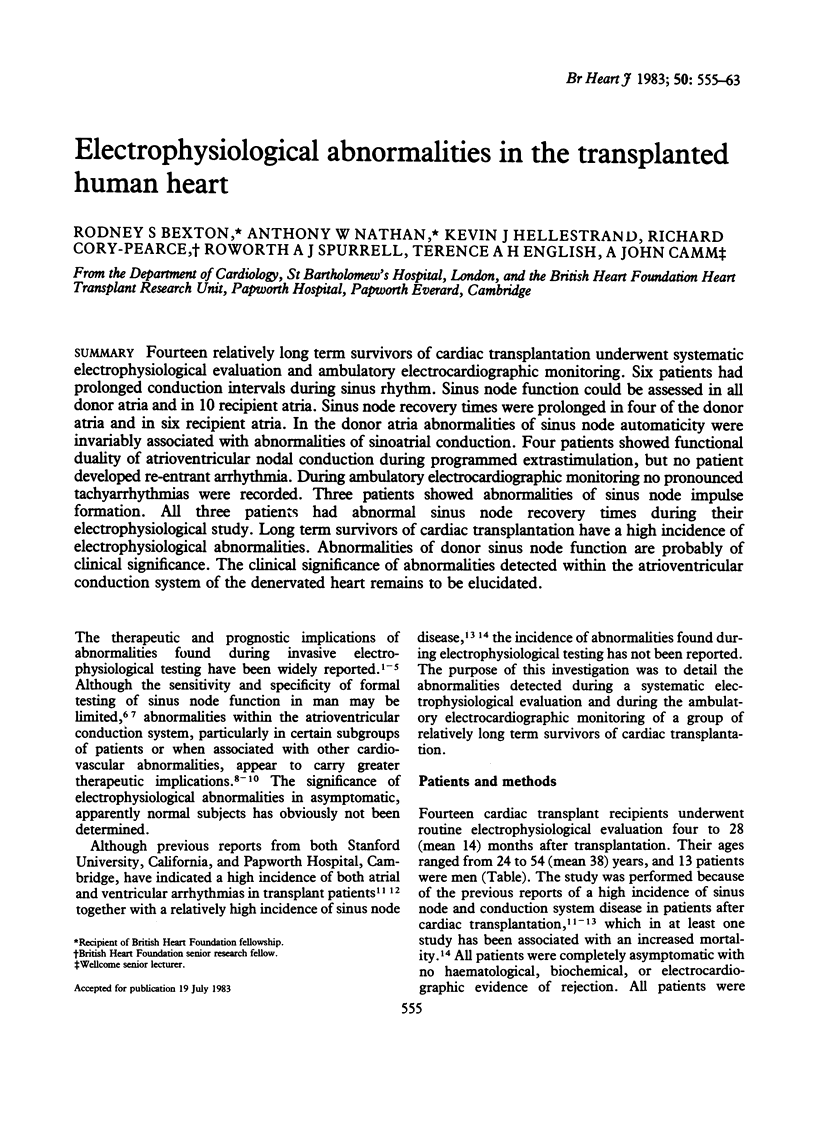

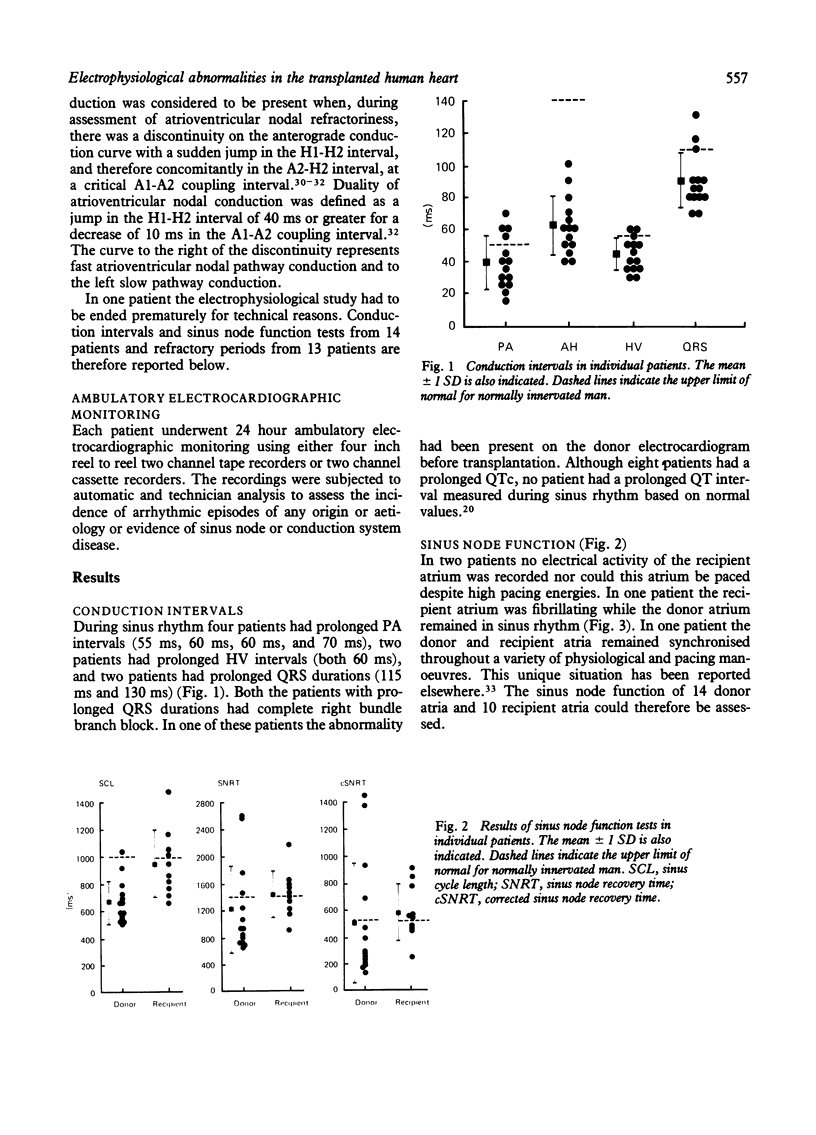
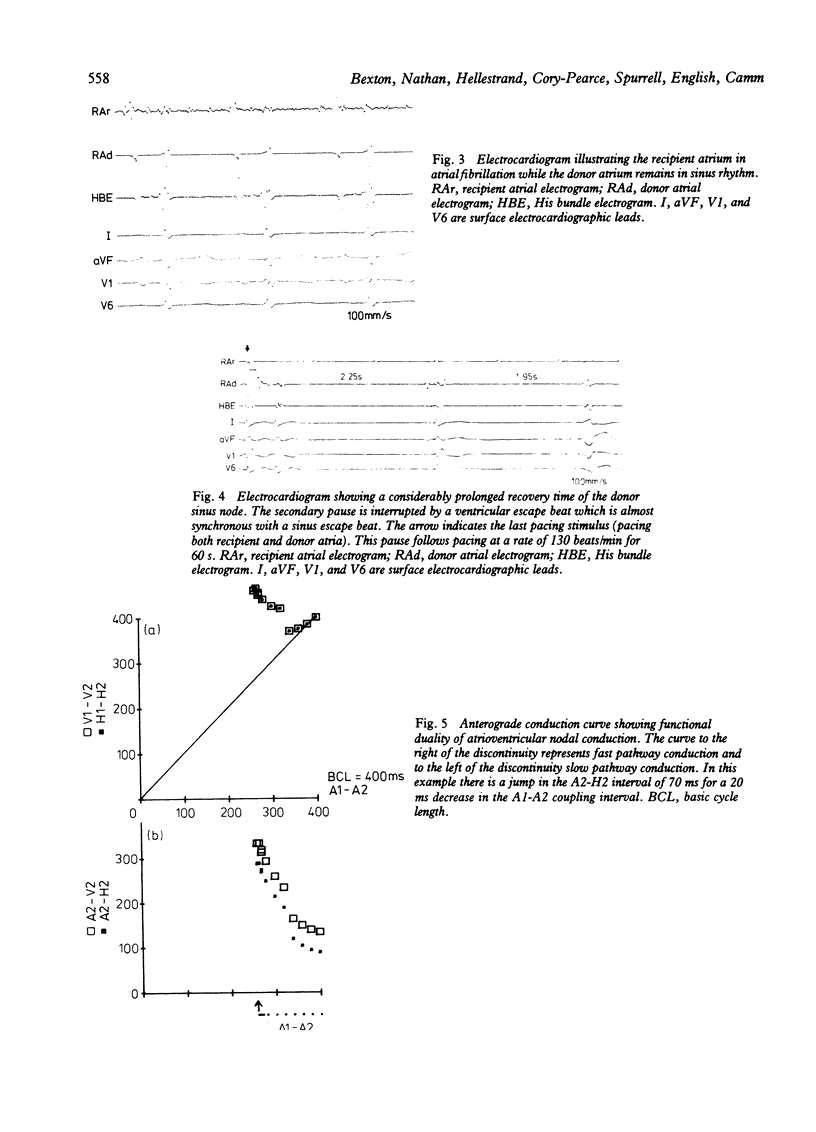
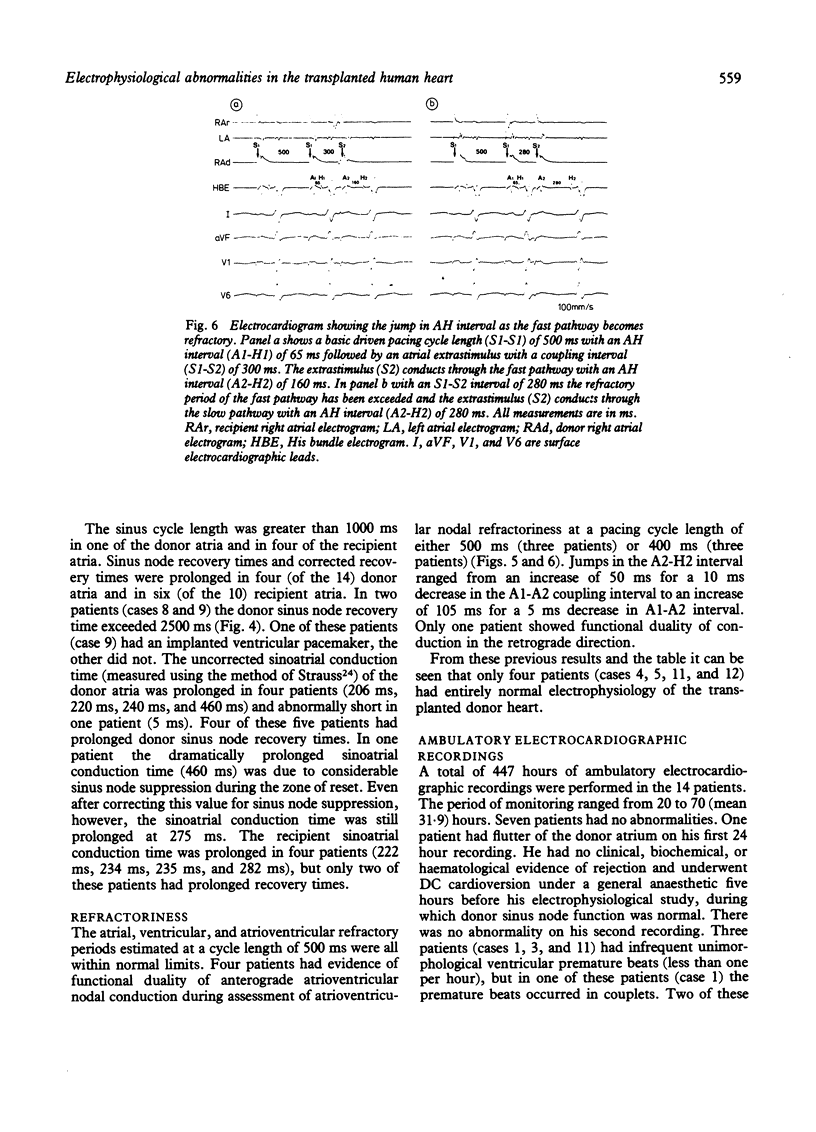
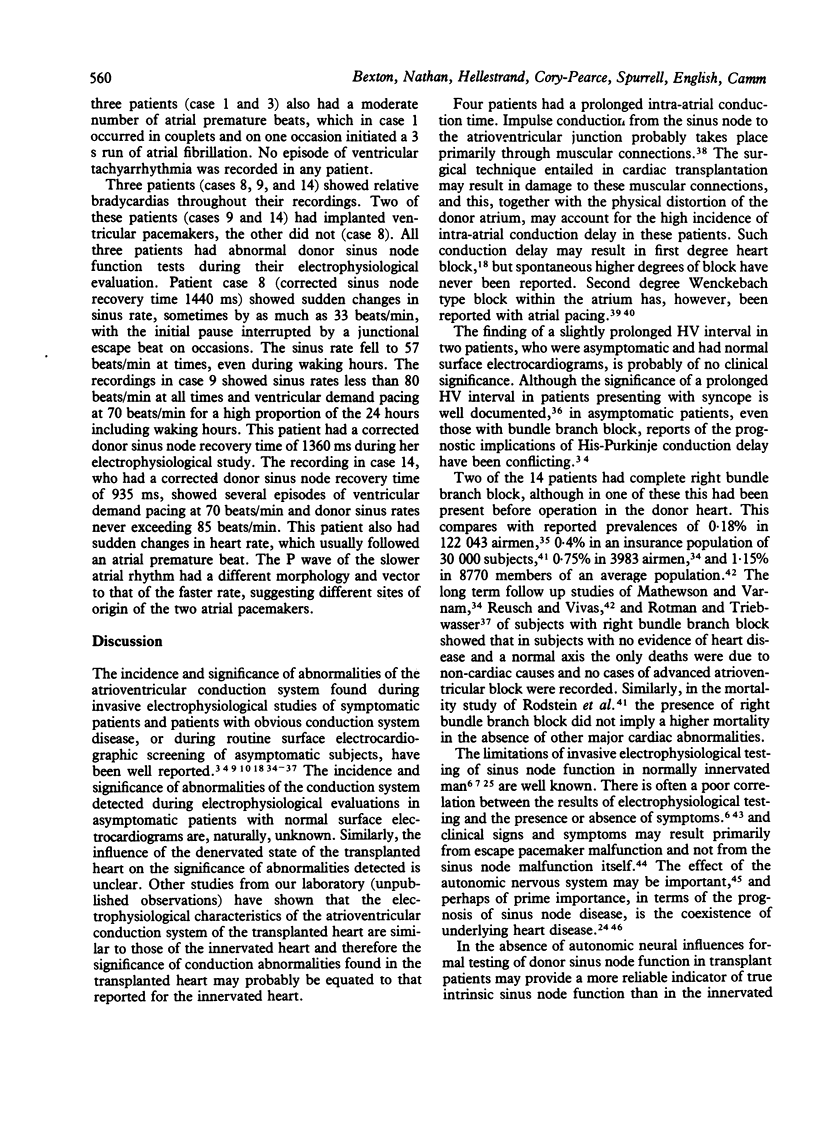
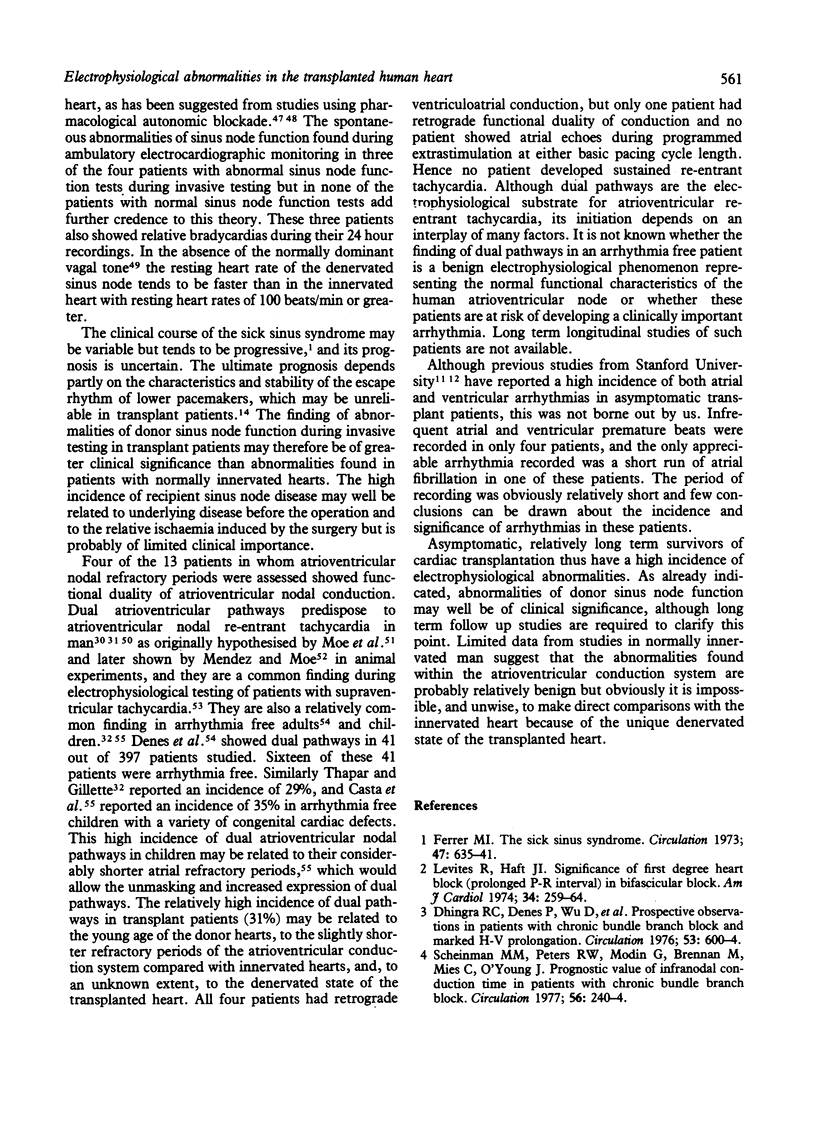
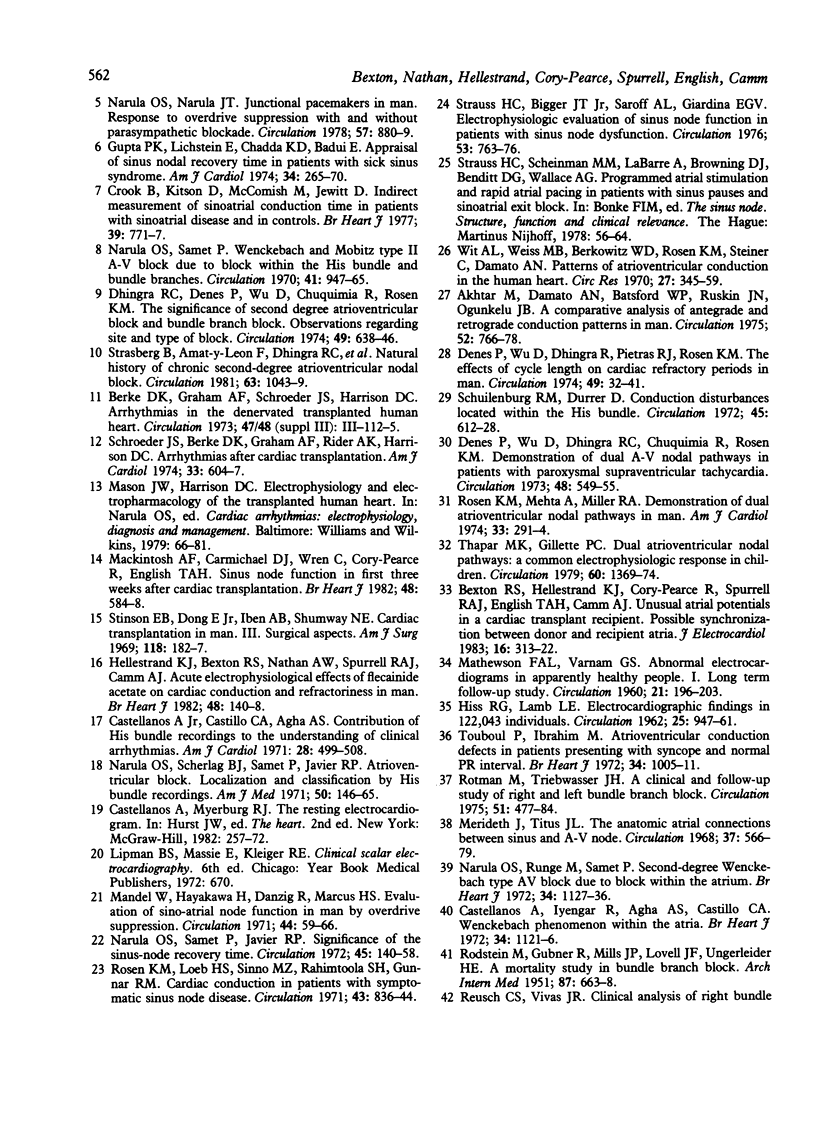
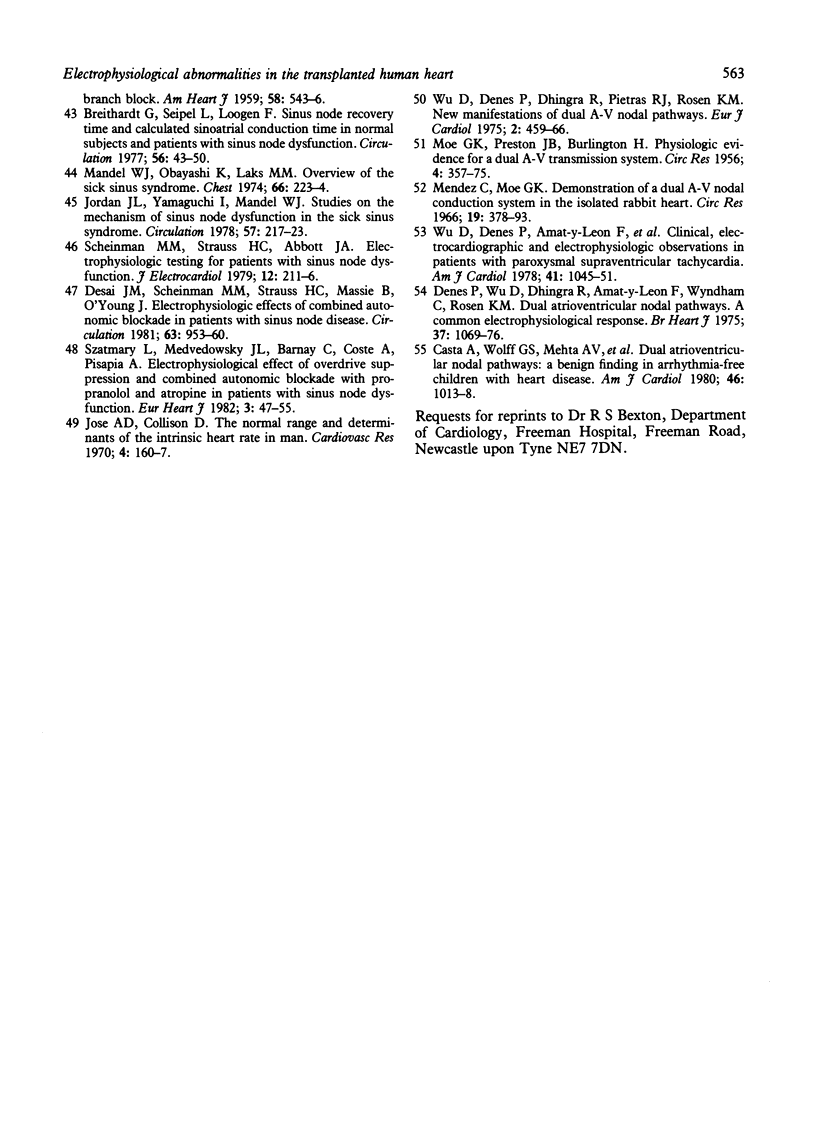
Selected References
These references are in PubMed. This may not be the complete list of references from this article.
- Akhtar M., Damato A. N., Batsford W. P., Ruskin J. N., Ogunkelu J. B. A comparative analysis of antegrade and retrograde conduction patterns in man. Circulation. 1975 Nov;52(5):766–778. doi: 10.1161/01.cir.52.5.766. [DOI] [PubMed] [Google Scholar]
- Bexton R. S., Hellestrand K. J., Cory-Pearce R., Spurrell R. A., English T. A., Camm A. J. Unusual atrial potentials in a cardiac transplant recipient. Possible synchronization between donor and recipient atria. J Electrocardiol. 1983 Jul;16(3):313–321. doi: 10.1016/s0022-0736(83)80012-0. [DOI] [PubMed] [Google Scholar]
- Breithardt G., Seipel L., Loogen F. Sinus node recovery time and calculated sinoatrial conduction time in normal subjects and patients with sinus node dysfunction. Circulation. 1977 Jul;56(1):43–50. doi: 10.1161/01.cir.56.1.43. [DOI] [PubMed] [Google Scholar]
- Castellanos A., Jr, Castillo C. A., Agha A. S. Symposium on Electophysiologic Correlates of Clinical Arrhythmias. 3. Contribution of His bundle recordings to the understanding of clinical arrhythmias. Am J Cardiol. 1971 Nov;28(5):499–508. doi: 10.1016/0002-9149(71)90091-9. [DOI] [PubMed] [Google Scholar]
- Castellanos A., Jr, Iyengar R., Agha A. S., Castillo C. A. Wenckebach phenomenon within the atria. Br Heart J. 1972 Nov;34(11):1121–1126. doi: 10.1136/hrt.34.11.1121. [DOI] [PMC free article] [PubMed] [Google Scholar]
- Crook B., Kitson D., McComish M., Jewitt D. Indirect measurement of sinoatrial conduction time in patients with sinoatrial disease and in controls. Br Heart J. 1977 Jul;39(7):771–777. doi: 10.1136/hrt.39.7.771. [DOI] [PMC free article] [PubMed] [Google Scholar]
- Denes P., Wu D., Dhingra R. C., Chuquimia R., Rosen K. M. Demonstration of dual A-V nodal pathways in patients with paroxysmal supraventricular tachycardia. Circulation. 1973 Sep;48(3):549–555. doi: 10.1161/01.cir.48.3.549. [DOI] [PubMed] [Google Scholar]
- Denes P., Wu D., Dhingra R., Amat-y-Leon F., Wyndham C., Rosen K. M. Dual atrioventricular nodal pathways. A common electrophysiological response. Br Heart J. 1975 Oct;37(10):1069–1076. doi: 10.1136/hrt.37.10.1069. [DOI] [PMC free article] [PubMed] [Google Scholar]
- Denes P., Wu D., Dhingra R., Pietras R. J., Rosen K. M. The effects of cycle length on cardiac refractory periods in man. Circulation. 1974 Jan;49(1):32–41. doi: 10.1161/01.cir.49.1.32. [DOI] [PubMed] [Google Scholar]
- Desai J. M., Scheinman M. M., Strauss H. C., Massie B., O'Young J. Electrophysiologic effects on combined autonomic blockade in patients with sinus node disease. Circulation. 1981 Apr;63(4):953–960. doi: 10.1161/01.cir.63.4.953. [DOI] [PubMed] [Google Scholar]
- Dhingra R. C., Denes P., Wu D., Chuquimia R., Rosen K. M. The significance of second degree atrioventricular block and bundle branch block. Observations regarding site and type of block. Circulation. 1974 Apr;49(4):638–646. doi: 10.1161/01.cir.49.4.638. [DOI] [PubMed] [Google Scholar]
- Dhingra R. C., Denes P., Wu D., Wyndham C. R., Amat-y-Leon F., Towne W. D., Rosen K. M. Prospective observations in patients with chronic bundle branch block and marked H-V prolongation. Circulation. 1976 Apr;53(4):600–604. doi: 10.1161/01.cir.53.4.600. [DOI] [PubMed] [Google Scholar]
- Ferrer M. I. The sick sinus syndrome. Circulation. 1973 Mar;47(3):635–641. doi: 10.1161/01.cir.47.3.635. [DOI] [PubMed] [Google Scholar]
- Gupta P. K., Lichstein E., Chadda K. D., Badui E. Appraisal of sinus nodal recovery time in patients with sick sinus syndrome. Am J Cardiol. 1974 Sep;34(3):265–270. doi: 10.1016/0002-9149(74)90025-3. [DOI] [PubMed] [Google Scholar]
- HISS R. G., LAMB L. E. Electrocardiographic findings in 122,043 individuals. Circulation. 1962 Jun;25:947–961. doi: 10.1161/01.cir.25.6.947. [DOI] [PubMed] [Google Scholar]
- Hellestrand K. J., Bexton R. S., Nathan A. W., Spurrell R. A., Camm A. J. Acute electrophysiological effects of flecainide acetate on cardiac conduction and refractoriness in man. Br Heart J. 1982 Aug;48(2):140–148. doi: 10.1136/hrt.48.2.140. [DOI] [PMC free article] [PubMed] [Google Scholar]
- Jordan J. L., Yamaguchi I., Mandel W. J. Studies on the mechanism of sinus node dysfunction in the sick sinus syndrome. Circulation. 1978 Feb;57(2):217–223. doi: 10.1161/01.cir.57.2.217. [DOI] [PubMed] [Google Scholar]
- Jose A. D., Collison D. The normal range and determinants of the intrinsic heart rate in man. Cardiovasc Res. 1970 Apr;4(2):160–167. doi: 10.1093/cvr/4.2.160. [DOI] [PubMed] [Google Scholar]
- Levites R., Haft J. I. Significance of first degree heart block (prolonged P--R interval) in bifascicular block. Am J Cardiol. 1974 Sep;34(3):259–264. doi: 10.1016/0002-9149(74)90024-1. [DOI] [PubMed] [Google Scholar]
- MATHEWSON F. A., VARNAM G. S. Abnormal electrocardiograms in apparently healthy people. I. Long term follow-up study. Circulation. 1960 Feb;21:196–203. doi: 10.1161/01.cir.21.2.196. [DOI] [PubMed] [Google Scholar]
- MOE G. K., PRESTON J. B., BURLINGTON H. Physiologic evidence for a dual A-V transmission system. Circ Res. 1956 Jul;4(4):357–375. doi: 10.1161/01.res.4.4.357. [DOI] [PubMed] [Google Scholar]
- Mackintosh A. F., Carmichael D. J., Wren C., Cory-Pearce R., English T. A. Sinus node function in first three weeks after cardiac transplantation. Br Heart J. 1982 Dec;48(6):584–588. doi: 10.1136/hrt.48.6.584. [DOI] [PMC free article] [PubMed] [Google Scholar]
- Mandel W. J., Obayashi K., Laks M. M. Editorial: Overview of the sick sinus syndrome. Chest. 1974 Sep;66(3):223–224. doi: 10.1378/chest.66.3.223. [DOI] [PubMed] [Google Scholar]
- Mandel W., Hayakawa H., Danzig R., Marcus H. S. Evaluation of sino-atrial node function in man by overdrive suppression. Circulation. 1971 Jul;44(1):59–66. doi: 10.1161/01.cir.44.1.59. [DOI] [PubMed] [Google Scholar]
- Mendez C., Moe G. K. Demonstration of a dual A-V nodal conduction system in the isolated rabbit heart. Circ Res. 1966 Aug;19(2):378–393. doi: 10.1161/01.res.19.2.378. [DOI] [PubMed] [Google Scholar]
- Merideth J., Titus J. L. The anatomic atrial connections btween sinu and A-V node. Circulation. 1968 Apr;37(4):566–579. doi: 10.1161/01.cir.37.4.566. [DOI] [PubMed] [Google Scholar]
- Narula O. S., Narula J. T. Junctional pacemakers in man. Response to overdrive suppression with and without parasympathetic blockade. Circulation. 1978 May;57(5):880–889. doi: 10.1161/01.cir.57.5.880. [DOI] [PubMed] [Google Scholar]
- Narula O. S., Runge M., Samet P. Second-degree Wenckebach type AV block due to block within the atrium. Br Heart J. 1972 Nov;34(11):1127–1136. doi: 10.1136/hrt.34.11.1127. [DOI] [PMC free article] [PubMed] [Google Scholar]
- Narula O. S., Samet P., Javier R. P. Significance of the sinus-node recovery time. Circulation. 1972 Jan;45(1):140–158. doi: 10.1161/01.cir.45.1.140. [DOI] [PubMed] [Google Scholar]
- Narula O. S., Samet P. Wenckebach and Mobitz type II A-V block due to block within the His bundle and bundle branches. Circulation. 1970 Jun;41(6):947–965. doi: 10.1161/01.cir.41.6.947. [DOI] [PubMed] [Google Scholar]
- Narula O. S., Scherlag B. J., Samet P., Javier R. P. Atrioventricular block. Localization and classification by His bundle recordings. Am J Med. 1971 Feb;50(2):146–165. doi: 10.1016/0002-9343(71)90144-6. [DOI] [PubMed] [Google Scholar]
- REUSCH C. S., VIVAS J. R. Clinical analysis of right bundle branch block. Am Heart J. 1959 Oct;58:543–546. doi: 10.1016/0002-8703(59)90088-2. [DOI] [PubMed] [Google Scholar]
- RODSTEIN M., GUBNER R., MILLS J. P., LOVELL J. F., UNGERLEIDER H. E. A mortality study in bundle branch block. AMA Arch Intern Med. 1951 May;87(5):663–668. doi: 10.1001/archinte.1951.03810050039004. [DOI] [PubMed] [Google Scholar]
- Rosen K. M., Loeb H. S., Sinno M. Z., Rahimtoola S. H., Gunnar R. M. Cardiac conduction in patients with symptomatic sinus node disease. Circulation. 1971 Jun;43(6):836–844. doi: 10.1161/01.cir.43.6.836. [DOI] [PubMed] [Google Scholar]
- Rosen K. M., Mehta A., Miller R. A. Demonstration of dual atrioventricular nodal pathways in man. Am J Cardiol. 1974 Feb;33(2):291–294. doi: 10.1016/0002-9149(74)90292-6. [DOI] [PubMed] [Google Scholar]
- Rotman M., Triebwasser J. H. A clinical and follow-up study of right and left bundle branch block. Circulation. 1975 Mar;51(3):477–484. doi: 10.1161/01.cir.51.3.477. [DOI] [PubMed] [Google Scholar]
- Scheinman M. M., Peters R. W., Modin G., Brennan M., Mies C., O'Young J. Prognostic value of infranodal conduction time in patients with chronic bundle branch block. Circulation. 1977 Aug;56(2):240–244. doi: 10.1161/01.cir.56.2.240. [DOI] [PubMed] [Google Scholar]
- Scheinman M. M., Strauss H. C., Abbott J. A. Electrophysiologic testing for patients with sinus node dysfunction. J Electrocardiol. 1979;12(2):211–216. doi: 10.1016/s0022-0736(79)80031-x. [DOI] [PubMed] [Google Scholar]
- Schroeder J. S., Berke D. K., Graham A. F., Rider A. K., Harrison D. C. Arrhythmias after cardiac transplantation. Am J Cardiol. 1974 May 6;33(5):604–607. doi: 10.1016/0002-9149(74)90249-5. [DOI] [PubMed] [Google Scholar]
- Schuilenburg R. M., Durrer D. Conduction disturbances located within the His bundle. Circulation. 1972 Mar;45(3):612–628. doi: 10.1161/01.cir.45.3.612. [DOI] [PubMed] [Google Scholar]
- Stinson E. B., Dong E., Jr, Iben A. B., Shumway N. E. Cardiac transplantation in man. 3. Surgical aspects. Am J Surg. 1969 Aug;118(2):182–187. doi: 10.1016/0002-9610(69)90118-4. [DOI] [PubMed] [Google Scholar]
- Strasberg B., Amat-Y-Leon F., Dhingra R. C., Palileo E., Swiryn S., Bauernfeind R., Wyndham C., Rosen K. M. Natural history of chronic second-degree atrioventricular nodal block. Circulation. 1981 May;63(5):1043–1049. doi: 10.1161/01.cir.63.5.1043. [DOI] [PubMed] [Google Scholar]
- Strauss H. C., Bigger J. T., Saroff A. L., Giardina E. G. Electrophysiologic evaluation of sinus node function in patients with sinus node dysfunction. Circulation. 1976 May;53(5):763–776. doi: 10.1161/01.cir.53.5.763. [DOI] [PubMed] [Google Scholar]
- Szatmary L., Medvedowsky J. L., Barnay C., Coste A., Pisapia A. Electrophysiological effect of overdrive suppression and combined autonomic blockade with propranolol and atropine in patients with sinus node dysfunction. Eur Heart J. 1982 Feb;3(1):47–55. doi: 10.1093/oxfordjournals.eurheartj.a061261. [DOI] [PubMed] [Google Scholar]
- Thapar M. K., Gillette P. C. Dual atrioventricular nodal pathways: a common electrophysiologic response in children. Circulation. 1979 Dec;60(6):1369–1374. doi: 10.1161/01.cir.60.6.1369. [DOI] [PubMed] [Google Scholar]
- Touboul P., Ibrahim M. Atrioventricular conduction defects in patients presenting with syncope and normal PR interval. Br Heart J. 1972 Oct;34(10):1005–1011. doi: 10.1136/hrt.34.10.1005. [DOI] [PMC free article] [PubMed] [Google Scholar]
- Wit A. L., Weiss M. B., Berkowitz W. D., Rosen K. M., Steiner C., Damato A. N. Patterns of atrioventricular conduction in the human heart. Circ Res. 1970 Sep;27(3):345–359. doi: 10.1161/01.res.27.3.345. [DOI] [PubMed] [Google Scholar]
- Wu D., Denes P., Amat-y-Leon F., Dhingra R., Wyndham C. R., Bauernfeind R., Latif P., Rosen K. M. Clinical, electrocardiographic and electrophysiologic observations in patients with paroxysmal supraventricular tachycardia. Am J Cardiol. 1978 May 22;41(6):1045–1051. doi: 10.1016/0002-9149(78)90856-1. [DOI] [PubMed] [Google Scholar]
- Wu D., Denes P., Dhingra R., Pietras R. J., Rosen K. M. New manifestations of dual A-V nodal pathways. Eur J Cardiol. 1975 Apr;2(4):459–466. [PubMed] [Google Scholar]


